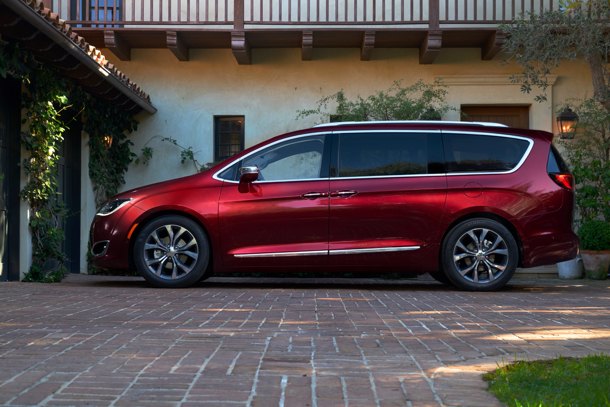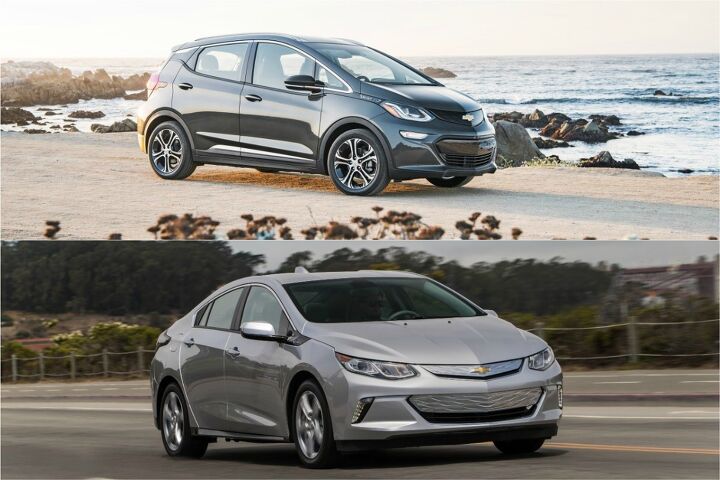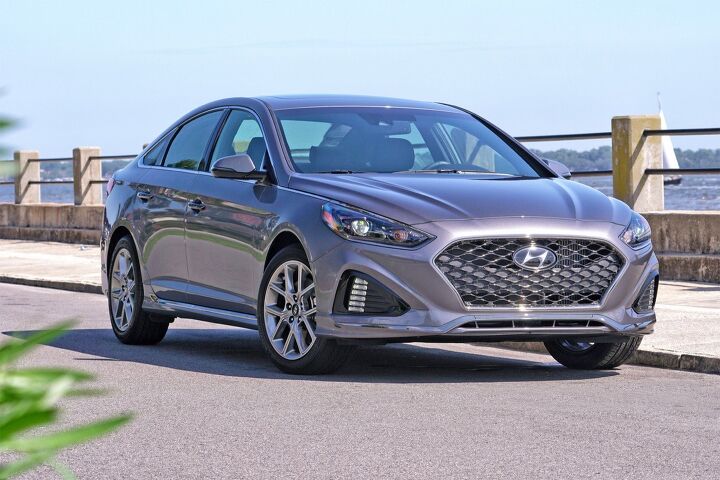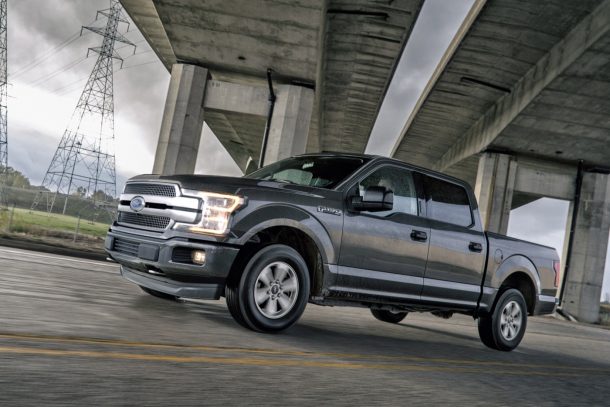#September2017Sales
Midsize Sedan Deathwatch #17: Trouble In October 2017, Unless Your Name's Honda Accord
U.S. sales of midsize cars plunged 16 percent to fewer than 130,000 units in October 2017, the lowest-volume month for the midsize sedan category since the winter doldrums of January.
For almost every player, from the forgotten Mazda 6 to the recently revamped Hyundai Sonata to the all-new Toyota Camry, there were fewer U.S. buyers in October 2017 than in October 2016. In most cases, far fewer. Hyundai Sonata volume plunged 49 percent, year-over-year, as Hyundai pulls away from daily rentals, clarifying just how little retail demand the Sonata truly musters. Double-digit percentage drops were also reported by the Kia Optima, Subaru Legacy, Volkswagen Passat, and Mazda 6.
But the sharp October tumble wasn’t reserved for each member of the midsize category. Newly launched this fall, U.S. sales of the 10th-generation 2018 Honda Accord predictably improved in October, driving Honda’s share of the segment up four points to 21 percent.
It’s a familiar story.
To Date, There Are 13 Volvo V90 Cross Countrys in America for Every Standard Volvo V90
Through the end of September 2017, Americans have registered 13 times more Volvo V90 CCs than Volvo V90s, clarifying with purchasing habits what every auto industry observer, casual or professional, already knew.
Volvo’s surely not surprised, either. After all, if you want to acquire a low-slung Volvo V90, Volvo forces U.S. customers to actually order the car. (Perish the thought.)
Even less surprising is the frequency with which Volvo now sells wagons. Combined, the four V60 and V90 variants account for fewer than one-in-10 Volvo USA sales through the first three-quarters of 2017.
America's Best-Selling SUVs and Crossovers Through 2017 Q3: Toyota RAV4 Primed to Break Honda CR-V Streak
For five consecutive years between 2012 and 2016, the Honda CR-V has been America’s most popular utility vehicle.
In fact, the CR-V has topped America’s SUV/crossover sales charts in nine of the last 10 years, a streak of dominance that began in 2007.
It appears increasingly likely in 2017, however, that the Honda CR-V’s streak will be broken by the Toyota RAV4. Thanks to 20-percent year-over-year growth through the first three-quarters of 2017, the RAV4 leads the CR-V by more than 31,000 sales and the Nissan Rogue/Rogue Sport by more than 15,000 sales with scant time remaining for the RAV4’s rivals to make up the gap.
The difference maker? Toyota’s RAV4 Hybrid.
Alfa Romeo Isn't Going to Meet Its 2017 Sales Targets - Blame China
Alfa Romeo is on track to sell between 130,000 and 140,000 vehicles around the globe in calendar year 2017, a far cry from the 170,000-unit performance Sergio Marchionne expected Alfa to put together.
U.S. sales remain predictably low by the standards of rival brands but are rising quickly now that the Stelvio SUV is in action. But on the other side of the Pacific, new rules that limit automobile manufacturers from forcing dealers to accept stock, Automotive News Europe reports, has sorely limited sales in China. Thus, rather than the 2,666 Alfa Romeo Stelvios shipped to China in July, only 227 landed in China in August.
The result? Alfa Romeo is cutting back production of the Stelvio and Giulia in Cassino, Italy.
American Minivan Sales Plunged to a 32-Month Low in September 2017
Minivan sales tumbled 16 percent to only 33,358 units in September 2017, the lowest total for America’s people-carrier sector since January 2015.
Between the disappearance of two nameplates (Nissan Quest and Mazda 5), limitations on Dodge Grand Caravan sales during a period of plant transition, and further decreases from the aging Kia Sedona and new Honda Odyssey, minivan volume fell 6,460 units below September 2016’s total and nearly 11,000 units shy of September 2015’s tally, and more than 10,000 units short of 2017’s monthly average through the first two-thirds of the year.
A positive spin is difficult to find.
If U.S. Auto Sales Were Growing Like Canadian Auto Sales, Americans Would Buy 18.5 Million Vehicles In 2017
In concert with the American auto industry, Canada’s auto industry reported an all-time record year of sales in 2016.
The difference? In Canada, 2016 represented the fourth consecutive year of record sales. Another difference? Canadian auto sales just kept on growing throughout 2017. Most recently, that streak of increases included an 8-percent year-over-year uptick in September 2017. Sales last month were 16-percent stronger than they typically are in September.
Month after month after month, Canada’s auto industry just keeps on smashing records. It’s as if the U.S. auto industry posted its banner year of 17.5 million sales in 2016 and then bettered that with 18.5 million sales in 2017.
That Brief Spell in Which America Was Cadillac's Biggest Market Ended in September 2017
By the slimmest of margins, Cadillac’s U.S. operations put an end to China’s repeated dominance of Cadillac’s sales charts in August 2017.
But after Americans acquired two more Cadillacs than the Chinese did in August, normal order returned in September 2017. 49 percent of the Cadillacs sold around the world last month were delivered in China, where volume rose 38 percent, year-over-year.
Perhaps of greater consequence to Cadillac’s New York HQ is the fact that September sales not only increased in China but also in the U.S., Canada, and in its rest-of-the-world markets.
September was the 16th consecutive month of global Cadillac sales improvement. Naturally much of the credit belongs to the Cadillac XT5.
The Chevrolet Bolt Is Now Far More Popular Than the Chevrolet Volt
If plug-in hybrids were meant to function as a stop-gap between ICE-powered cars and fully electric cars, it may be time to consider Chevrolet gapless.
The Chevrolet Volt appeared in first-gen form in late 2010. By 2016, with the arrival of a second-generation edition, Volt sales climbed to record levels in the United States, albeit still not at the level GM originally hoped to see.
The Volt was and is a plug-in hybrid, an electric car with a range-extending gas-powered engine.
But with nationwide availability of the Chevrolet Bolt — change that V to a B for pure electricity — we’re now watching as Chevrolet Volt sales tumble. It turns out General Motors now has far more U.S. demand for its electric car than its ICE-accompanying electric car.
Midsize Sedan Deathwatch #16: The Decline of the Midsize Class's Middle Class
Ever more minor midsize players continued to see their share of America’s midsize sedan segment dwindle in September 2017. The cause: domination on the part of America’s two major midsize cars.
The all-new 2018 Toyota Camry enjoyed its first full month of meaningful availability in September and produced a 13-percent year-over-year U.S. sales improvement as a result. Meanwhile, Honda is clearing out remaining 2017 Accords in advance of the all-new 2018 Accord’s arrival this fall. Honda’s efforts produced a 10-percent uptick compared with September 2016.
Yet despite the big gains from the two major players, the upper class, the midsize segment still declined 7 percent in September because of sharp declines by many members of the middle class.
That means Camry and Accord market share continues to rise. That means the slice of the market earned by the middle class continues to shrink.
Camry Crusher: Honda Civic Expands Lead as America's Best-selling Car
In many ways, September 2017’s auto sales bucked the trend. After the industry combined for decreased volume, year-over-year, in each of 2017’s first eight months, auto sales in September rose 6 percent. Meanwhile, the shrinking car sector that tumbled 12 percent through the first two-thirds of 2017 was down only 3 percent in September.
There were two big reason the passenger car decline wasn’t worse: America’s two best-selling cars.
Excluding the Honda Civic and Toyota Camry, U.S. car sales fell 6 percent. But as the clear-out of remaining 2017 Honda Accords got underway and produced 10-percent growth, the launch of the 2018 Toyota Camry generated a 13-percent uptick. Meanwhile, the Honda Civic’s 26-percent surge allowed the compact Honda to expand its lead over the midsize Camry in the race to end 2017 as America’s best-selling car.
Midst Yet Another FCA Sales Decline, Jeep Shows Powerful Signs of Life
September 2017 sales at Fiat Chrysler Automobiles decreased on a year-over-year basis for a 14th consecutive month, extending a stretch of declines that began in August of last year.
For much of that time span, the U.S. automobile industry was reporting declining sales, as well. And for much of that time span, even as total U.S. auto sales kept on sliding, SUV/crossover sales were rising. For much of that time span, Jeep sales were falling.
Technically, officially, Jeep sales kept on falling in September 2017, the U.S. auto industry’s first month of improved sales this year.
But if you’d just ignore the Jeep Patriot for a moment, we can look at a clearer picture.
Four Reasons Why September 2017's U.S. Auto Sales Picture Isn't As Rosy As It Seems
In September, for the first time in 2017, auto sales were higher this year than last.
Substantially higher.
Compared with September 2016, auto sales in America last month were 6 percent higher, far healthier than the modest sub-1-percent uptick analysts predicted. Booming pickup truck volume, big gains from America’s best-selling SUVs and cars, continued growth from trend-bucking Subaru, and rebounds at Volkswagen resulted in an industry that reported 1.5 million total sales, nearly 90,000 more than in September 2016.
The seasonally adjusted annualized rate shot up to 18.6 million, the best SAAR since July 2005, according to Automotive News. Over the last half-decade, Americans have averaged fewer than 1.3 million September new vehicle acquisitions. Last month’s result was 18 percent better than the September average.
Sunshine and roses? An end to the U.S. auto industry’s gradual slide? A sign of a perfectly healthy market? We have four reasons you should be skeptical.
U.S. Auto Sales Brand-by-Brand Results: September 2017 YTD
U.S. auto sales exceeded analyst expectations with a big 6 percent year-over-year increase to 1.5 million units in September 2017, the first monthly improvement in 2017 so far.
After auto sales fell 3 percent during the first two-thirds of 2017, big September increases from Toyota Motor Corp., General Motors, Ford Motor Company, American Honda, Nissan’s trio of brands, and numerous smaller outfits brought the sales pace achieved through the first three-quarters of 2017 within sight of 2016’s record rate. By the end of September, U.S. auto sales are down by less than 2 percent compared with last year.
Pickup trucks played a major role in September’s improvements, growing at twice the rate of the industry at large. The Honda Civic expanded its lead as America’s best-selling car on a quest to end the Toyota Camry’s 15-year run. Minivan sales plunged to barely more than 33,000 units. The Toyota RAV4 topped 42,000 sales for a second consecutive month, leading a booming SUV/crossover class.
September 2017 Was a Terrific Month For Pickup Truck Sales in America
September 2017 sales of pickup trucks rose to the highest level so far this year in the United States, jumping 12 percent to 257,864 units.
Prior to this point, truck sales had grown by less than 4 percent, year-over-year, averaging slightly more than 225,000 monthly units.
September’s big gain was fuelled almost entirely by improvements among the full-size pickup trucks that own 84 percent of America’s pickup truck market. And America’s full-size pickup truck gains were powered in large part by America’s best-selling line of vehicles: the Ford F-Series.
For the First Time in 2017, September Auto Sales May Have Increased, Slightly, Perhaps
Both Edmunds and Kelley Blue Book are forecasting marginal year-over-year sales increases for the U.S. auto industry in September 2017.
If the analysts prove correct, it will be the industry’s first month of growth since December of last year. What’ll it take to push the industry beyond the 1.43 million new vehicles sold in September 2016?
The big gains from General Motors and Toyota will have to be big enough to overcome big losses from Fiat Chrysler Automobiles and Hyundai-Kia.






























Recent Comments